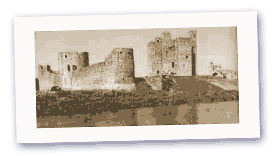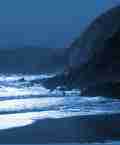

Trim Castle, County Meath
Trim Castle is the largest and one of the most important Norman military constructions in Ireland. Its well-deserved reputation as the king of Irish castles rests upon its imposing curtain walls enclosing over three acres, its fine gatehouses, and its enormous isolated keep - all of which project a visually striking image of foreboding might and great power.
The first fortification on this site above the banks of the Boyne was a motte erected by Hugh de Lacy in 1172. After this was destroyed by Roderick of Connaught in 1174, de Lacy embarked on building another castle, the nature of which has not yet been established. On the basis of the present limited evidence, it seems likely that the curtain wall and the huge stone keep, which envelopes the stump of the old motte, were begun by de Lacy during the 1170s. Structural examination of the keep has shown that it was built in two major phases, which were probably close together but not continuous. It is thought that this break in construction corresponds with the minority of Hugh de Lacy's eldest son Walter between 1186 and 1194, when the Lordship was held be Prince John. Work may still have been proceeding when King John came here in 1210, for the following year, after the Crown had taken control of the castle, the sum of £64 was spent on building work, including "22/- for a large horse ... for strengthening the tower". The keep was probably being completed around this time.
and the huge stone keep, which envelopes the stump of the old motte, were begun by de Lacy during the 1170s. Structural examination of the keep has shown that it was built in two major phases, which were probably close together but not continuous. It is thought that this break in construction corresponds with the minority of Hugh de Lacy's eldest son Walter between 1186 and 1194, when the Lordship was held be Prince John. Work may still have been proceeding when King John came here in 1210, for the following year, after the Crown had taken control of the castle, the sum of £64 was spent on building work, including "22/- for a large horse ... for strengthening the tower". The keep was probably being completed around this time.
The design of the keep is most unusual, comprising a massive square block with towers projecting from the middle of each face (only three out of the original four remain). On plan it looks like a combination of a square and a Greek cross. The towers have thinner walls than the main core and appear to have been added, not for defensive reasons, but to provide extra rooms and possibly because they looked good. Three of the four projections have ground floors, but the main core of the keep at this level is evidently filled with earth. The entrance is within the east tower at first-floor level, below the chapel, and access to the three floors of the centre block is provided by a mural winding stair in the south-west and north-east angles.
The first floor and second floors are divided by a central wall, but the third floor was one large apartment and was clearly the main room in the castle - most probably the lord's chamber. Mural passages gave access to the rooms in the side-towers, though on the top floor galleries linked some of these subsidiary rooms with one another, without needing to enter the centre block at all.
> > > Read the concluding part of this article.
Click here Irish Castles to buy the book from Amazon.com or here to buy the Appletree Press book from Amazon.co.uk. For more information of the Appletree Press title, click on: "Irish Castles".
[ Back to Top | to Irish Castles | to Attractions ]
All Material © 1999-2006 irelandseye.com and contributors Privacy statement
